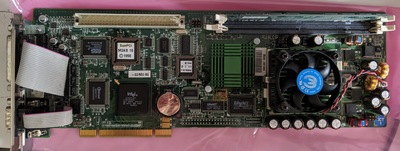SunPCi
The SunPCi is a single board Socket 7 x86 PC fitted with either a 300MHz (option 1131A-64.1, part 375-0075) or 400MHz (option 1131A-64.2, part 375-0095) AMD K6-2 CPU, SiS 5598 chipset providing USB and VGA, ESS AudioDrive ES1869F audio, Winbond W83877TF I/O and Digital DECchip 21154 PCI-to-PCI bridge. Ports include: VGA, USB, Audio line in and out, headphone in, 9-pin serial and 25-pin parallel.

This card is designed to be installed in a PCI-equipped Sun SPARC workstation running Solaris 2.5.1 or newer and version 1.x of the SunPCi software. Software running on the host workstation provides emulated drives and network as well as keyboard and mouse input. It can optionally provide emulated video output to a window on the host workstations display, or the cards built-in VGA port provided by the SiS chipset can be used with a second display.
Supported guest operating systems are DOS (Caledera OpenDOS supplied), Windows NT Workstation 4.0, Windows 2000, Windows 95 and Windows 98. Guest drivers are provided which provide access to the host SPARC workstations filesystem, bridged networking with the hosts network interface, control of the hosts CD-ROM drive, mouse and clip-board integration. Given the way drive emulation is handled you'll likely have
great difficulty getting any other OS to run.
Software
The SunPCi software is required to use this card with the last compatible version being 1.3. This used to be a free download from Sun but the original pages are long gone. You can grab a copy of version 1.3 here: SUNWspci_13.tar.Z.
Use with Solaris 9
Solaris 9 is not supported by SunPCi 1.x and the package will fail to install correctly but it can be made to work. Just install the software normally and once its failed, do the following then reboot:
cd /opt/SUNWspci/drivers/solaris
ln -s /opt/SUNWspci/drivers/solaris/sunpcidrv.280 sunpcidrv.290
ln -s /opt/SUNWspci/drivers/solaris/sunpcidrv.280.64 sunpcidrv.290.64
You'll also need to install the latest Solaris 9 Recommended patch cluster otherwise the SunPCi software will abort when Windows 9x (with the SunPCI drivers) or NT boots. You can grab the last freely available patch cluster here: 9_Recommended.zip, Readme
Installing an Operating System
The first step is to create a new hard disk image. For Win2k you need at least 2GB, for everything else 500MB should enough. Disk images larger than 2GB for the C: drive are not recommended unless you want to mess around with Partition Magic later to resize partitions. The disk images are not sparsely allocated - if you create a 500MB disk image then it will occupy 500MB of disk space.
All new disk images are preformatted with the FAT filesystem with Caldera OpenDOS 7.01 installed along with the SunPCi redirector software providing access to the host workstations filesystem. Drive F:
is by default mapped to /opt/SUNWspci/drivers and R: mapped to the root filesystem.
Windows 95/98
As drive R: is mapped to the root filesystem and you're running DOS, you can just install windows normally. Insert the Windows 95/98 CD and run R:\cdrom\cdrom0\setup.exe. The install process should be pretty normal.
Once windows setup has completed you'll need to install the SunPCi drivers. These will be available in F:\win95 or F:\win98. These drivers will provide vastly better graphics performance along
with networking, mouse integration, etc.
Windows NT Workstation 4.0
The installation process for Windows NT 4.0 is very special. Don't try to use the setup floppy disks - they will not work. Instead insert your Windows NT CD-ROM and run F:\drivers\winnt\setupnt.exe from DOS. This will kick off a largely automated process which will:
- Copy Windows NT setup files to C:
- Reboot and begin an upgrade install of Windows NT. The blue stage of NT setup won't ask any questions.
- Reboot into Windows NT to continue with the graphical portion of the setup. You'll notice here that the background image has been changed to a picture of the SunPCi card
- You'll be prompted for your name and organisation, a CD key, a hostname and an administrator password
- The rest of the install will proceed automatically with no further user input required.
- And a final reboot into Windows NT.
The end result will be Windows NT installed alongside DOS on a FAT formatted hard disk with the SunPCi drivers all installed and configured. From here you'll want to install at least Service Pack 4.
Windows 2000 Professional
The process for this is similar to that for Windows NT Workstation 4.0. Insert the Win2k CD and run F:\drivers\win2k\setupw2k from DOS. The documentation notes that your mouse may not work until after you login to Windows.
Accessing the Host Filesystem
To access the host workstations filesystem you must map it as a network drive using a path such as \\localhost\home\david to map /home/davd
Notes
- DHCP seems to not work properly with NT4 at least. You'll get an IP address and be able to ping other hosts but windows networking and other services will be unreliable or won't work. Setting a static IP seems to resolve these issues
- I've not yet been able to get the CD-ROM drive to work under Windows NT4. I just access it via Solaris by mapping a drive to \\localhost\cdrom\cdrom0
- The SunPCi application requires the Sun X server. If you want to use remote X it will have to be from another Solaris box.
- If you want to run DOS games you'll need to use an external display; the emulated VGA is too slow and imperfact
- Audio is not passed through to the host workstation; if you want to hear audio from the guest through your workstations speakers you'll need to connect the SunPCi line out to the workstations line in
- The 400MHz part is incompatible with the retail version of Windows 95; OSR2 or newer is required with the AMDK6UPD.EXE patch. See SunPCi Important Note for more information.
Documentation
Links

